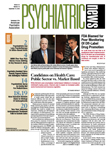A New York Times article published just as the first Board of Trustees meeting of the APA year was about to begin noted that the topic of our report to Sen. Grassley (R-Iowa) would be discussed there “behind closed doors.”
That made me wonder how many organizations, including the New York Times, have their Board meetings behind “open doors.” Then I received an e-mail from a colleague. After expressing her resentment at the unfair focus on psychiatrists, she wrote that she would have loved to be a“ fly on the wall” at our Board meeting. As a matter of fact, aside from an hour or two during some meetings for the discussion of sensitive personnel or legal issues, the meetings of the APA Board, like all APA meetings, are open to any APA member. Psychiatric News reports Board decisions, but maybe that doesn't capture the nature of the process. If you were a fly on the wall, here's what you would see and hear.
The Board has full meetings four times a year and has a brief ceremonial meeting in May. It also holds conference calls at least monthly. Board members make written and verbal disclosures of “interests.” We correct and approve the minutes of the last Board meeting, as well as any urgent decisions that had to be made by the Executive Committee (the APA officers) between meetings. An example of one such action is the approval of a grant to a district branch facing a legislative challenge. The medical director and his staff report on the activities of each of our departments: Communications and Public Affairs, Government Relations, Health Care Systems and Financing, Minority and National Affairs, and Research, among others (these reports are posted on our Web site). We learn what's happening on DSM-V. The secretary-treasurer, chair of the Budget and Finance Committee, and chief financial officer present a detailed report on the state of APA's finances. (The Financial Oversight Committee meets by telephone once a month to make in-course corrections so that we maintain a balanced budget.) The speaker presents Assembly actions for Board consideration.
The presidents or presidents-elect of two district branches are invited to each Board meeting to learn how the Board functions, tell the Board and the staff what's happening in their parts of the country, and ask questions or present problems. This year we will include the president and chief executive officer of a major mental health advocacy group at each meeting. Our collaboration with advocacy groups is essential in our work with the government and the public. We are mindful of the “consumer” adage:“ Nothing about us without us.” We are considering the addition of a member of the public to our Board; let me know what you think about that. Is it a good idea, and, if so, what kind of experience or background should that person have?
The rest of the Board meeting is taken up with other issues. After I draft the agenda for each meeting, I circulate it to the Board for comment, and I welcome your suggestions for agenda items as well. Our next meeting will be immediately after next month's Institute on Psychiatric Services in Chicago. I hope you are planning to attend the institute, and I invite you to stay on to observe the Board meeting. If you let me know in advance, I will introduce you and ask one of the Board members to assist you.
At our October meeting, the Board will receive an interim report from the work group charged to detail our revenues from the pharmaceutical industry and our expenditures on APA activities, and to offer the Board options for the possible decrease or discontinuation of the various kinds of revenues we accept from pharma. We will make no policy decisions until we have seen and discussed those options at our March meeting. Recently Dr. Jay Scully, our medical director, Eve Herold, our new director of Communications and Public Affairs, and I met with the New York Times reporters who have been writing about relationships between physicians and medical industries. We offered them the same information we gave Sen. Grassley and the opportunity to ask us to explain it.
APA members can access information on the meetings of the Board of Trustees on APA's Web site at<www.psych.org/Resources/Governance/BoardofTrustees.aspx>. You elect the APA Board, and we are answerable to you. The list of Board members is on the Web site and in each issue of the American Journal of Psychiatry. ▪

